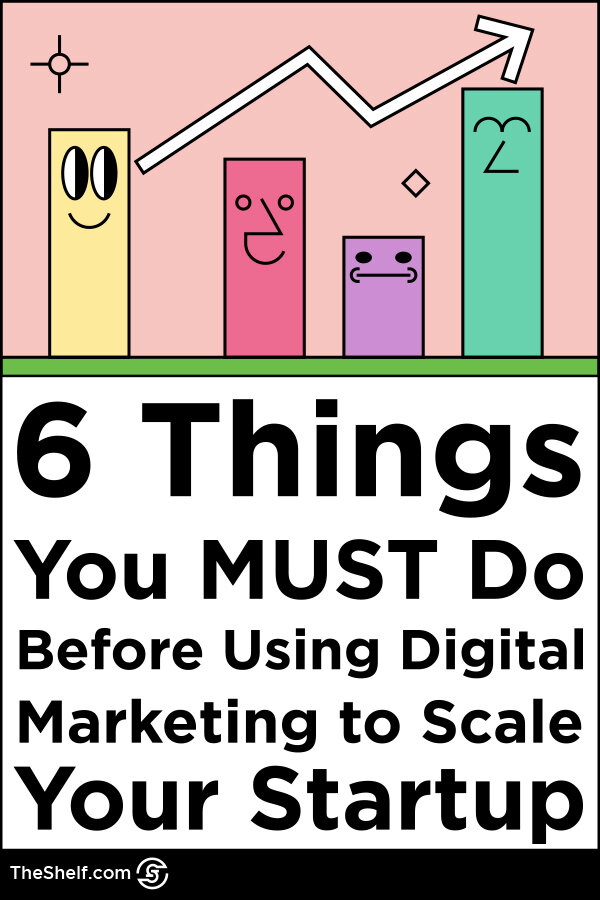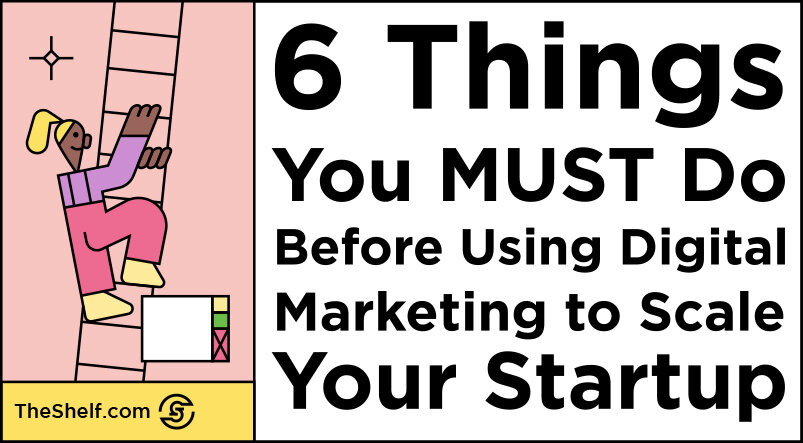This generation is no stranger to innovation and the fact that businesses spring from ideas that can really come from anywhere. Startup culture has been part of the American experience for decades, but not ever startup survives. The ones that struggle to make it to the next fiscal quarter will usually do so because they don’t have the cashflow to sustain the business - they don’t have the customer base. And, as you know, that’s all this blog really talks about - leveraging the power of digital marketing and social media marketing to reach buyers at different points along the path to purchase.
So, we want to back up a bit and lay the foundation for positioning a new business for growth with smart digital marketing. With strategic online marketing, even bootstrapped startups can create engaging marketing campaigns that reach sales-qualified buyers. With that in mind, let's look at some of the most effective marketing strategies for startups, as well as how to develop them.
6 Steps Startups Can Take to Fast-Track Their Growth with Digital Marketing
This isn’t an indictment. I’m not saying you don’t already have a pretty solid idea of who your buyer is and what makes them buy. The next step is knowing how they navigate your path to purchase.
No matter the market you plan to enter, knowing your target audience will play a vital role in how successful your marketing campaigns can be. There’s a stat that says up to 90% of startups end up failing. One reason is that they don't give enough attention to how they’re reaching their audience, and this step alone can end up derailing the entire marketing campaign.
So, before you can start thinking about specific strategies that you could use, you'll need to take a deep dive into analyzing your audience from all angles. Here are a few tips:
Identify your ideal customers. If you already have customers, you should look at the ones you're able to help the most and those who generate the most income for your company. If you need to expand your audience, start by looking at how they shop and where they spend time online.
Talk to your audience. One of the biggest benefits of working with influencers is they’re in constant contact with their followers, and they’ve mastered the art of creating content that resonates with their followers. That kind of real-time feedback can help brands shape marketing messages, figure out which products will work and which won’t, and offer valuable insights on the conversations happening in your
Collect data and insights. By running surveys and organizing interviews with prospective customers, you can learn a lot about how they perceive the products that are on the market and what are the biggest obstacles that they're trying to overcome.
Create customer avatars. Once you compile the necessary information, put together a customer avatar, and list the essential information about the people you want to reach. Consider what they are looking for, where they usually hang out online, and the types of messages that could draw their attention.
This will help you decide which marketing approaches would be the most effective in your situation, allowing you to make the most out of your budget and achieve the best results.
Once you know where your audience works, lives, and plays online, you can have a better understanding of which marketing channels - specifically which social media channels - will deliver ROI. AND you’ll know what kind of content to create for your campaign, including guiding your decisions in terms of branding, messaging, and the voice that you end up using.
For instance, when targeting B2B audiences, you will usually find few customers on social media sites like Instagram but might achieve amazing results on LinkedIn or with highly-targeted Facebook campaigns.
Depending on the type of product that you're selling, you might find that the audience you're targeting uses a wide variety of platforms, which can be a great opportunity to slowly expand your reach by using a range of different marketing methods.
You may even find that at least initially, your best bet will be to reach out to customers directly, identifying key decision-makers and pursuing them to get the ball rolling. This can also help you test out your product and tweak your approach, building up some credibility that you can later use for broader marketing campaigns.
This is one that gets skipped often, but competitor analysis is important. Have you noticed how much more lively and personable insurance commercials are these days? DJ Khaled is doing insurance commercials. NBA star Chris Paul is in spots for State Farm. Flo (Progressive), the gecko (GEICO), Allstate’s Mayhem and Dennis Haysbert (the guy with the deep voice)… all of these personalities are featured in content that clearly appeals to younger insurance customers. So…
If you’re entering the insurance business and you’re focusing on the necessity of your product (which is how they played out 15 years ago, and so obvious you REALLY don’t have to tell people they need it), you’d be hard-pressed to become a household name. The messaging has changed to meet the needs and pique the interests of the millennials and Gen Zers who have become the insurance industry’s core customer. In an environment where insurance companies are building their brands and their clientele by creating entertaining content, you can’t win the brand awareness game if you’re making the stuffy commercials your grandparents responded to between radio broadcasts of baseball games. Haha. Kidding. Most granddads probably watched major league baseball on on regional TV networks (real fact).
The point here isn’t to copy your competitors. But by watching what established brands are doing in the space, you can get an idea of the types of content that work with your buyers. No need to reinvent the wheel if those round ones are still everybody’s jam.
No matter how you look at it, it's almost impossible to make sales online without having messages and content that can make a strong case for what you're offering. Content is an integral part of early-stage startup marketing, not only because it helps attract more prospective customers, but also because it helps tell the brand's story.
Early on, when your brand doesn't have a reputation and a long track record, producing content that's helpful and informative is one of the best ways to earn your audience's trust and slowly build your credibility. And if you don’t want to go crazy trying to meet the massive content demands every brand faces, you need to also learn to repurpose sponsored content and reimagine in-house content for greater and greater reach.
But even though articles remain a dominant form of content, you should not limit yourself to your blog if you want to achieve the best results.
In many industries, especially in the B2B world, other types of content, such as infographics and slides play a vital role in giving your content legs as well as attracting qualified prospects that can be engaged and nurtured.
Video marketing is also a must for every business at this point. Not only does it help instill confidence and generates more engagement, but it helps you reach a broader audience and makes storytelling a little more fluid. Unlike the old days (I mean, like the 90s and early 2000s), making videos can be as simple as using your late-model iPhone and downloading an online video maker to your phone to edit it.
Referrals are the lifeblood of many businesses, but a lot of startups overlook referral marketing as a viable strategy for not only repeat business, but expanding their customer base. But while it's true that you must have ways to keep your signup numbers growing, relying solely on content marketing and paid ads is sustainable, but not the most prudent strategy.
In fact, some of the most successful startups in recent years have shown that it's possible to reach millions of people using a simple, but incredibly effective, referral system.
If you can position your product to garner attention, you can potentially make it go viral, spreading across the web and becoming the talking point of the entire industry that you're operating in. Companies like Snapchat or Dropbox build their customer base with minimal spending on ads, relying instead on their own customers to spread the word about their company and ensuring that for every customer they brought in, they would get at least another one by referral.
To make referral marketing your best growth strategy, you must take a structured approach that gets people to take the time to share your product.
If your customers are satisfied, sometimes even a simple nudge in the form of a request might be enough. More often than not, however, you will probably need to incentivize the effort at least a little bit since you are asking people to take the time out of their life to help you.
Even offering a simple discount can sometimes be all that's needed to get people to spread your message. After all, your customers are already satisfied with what you have to offer, so if you give them a little nudge in the form of a reduced price or an appealing bonus, there's a big chance that they will be willing to help you out.
If you want to take your efforts to the next level, you could consider partnering up with influencers in your market who can help you refine your messaging, build brand awareness, and send traffic - and sales - to your website. And they can do it in a matter of days!
Sure, as an early-stage startup, you may not have the ability to partner up with the largest influencers used by some of your competitors. However, there are actually advantages to going smaller with your influencer selection process.
There are a bunch of different advantages to partnering with nano-influencers and micro-influencers. One of the main benefits is that smaller influencers tend to have more niched-down audiences, which means while you’ll be reaching a smaller audience, percentage-wise, you’re likely to reach more of your buyers.
And even though a single influencer's reach might be smaller, you can compensate by working with multiple people and creating a buzz around your product in your market.
Over time, it will help your startup become noticed and potentially even become the talking point in your industry.
Final Words
Successfully launching and growing a startup is a challenging task, which is why so many fail every year, even though some accumulate substantial financial backing.
However, if you develop sound marketing strategies, take the time to understand your audience, and produce a wide range of content, you will always be in an excellent position to succeed, and will have a solid understanding of what's working and what isn't.
ABOUT THE AUTHOR
Dave Schneider is a serial entrepreneur who co-founded Shortlist in 2018, a marketing un-agency that serves as an outsourced, dedicated marketing team.
Dave also co-founded Less.churn, a churn reduction app, prior to selling it in 2018. In 2012 he quit his job to travel the world, and has visited over 65 countries to date.

We partner brands with creators who are experts at using multimedia content to tell amazing stories. And we build campaigns that seamlessly tie together your other marketing channels. Seriously... we’re all about that ROI.
SCHEDULE A STRATEGY SESSION
Or click below to call
(212) 655-9879









